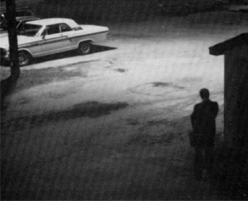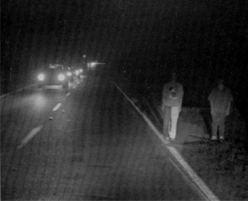By
George S. Pearl
When the sun goes down, human reaction
time and visibility deteriorate. A reaction time of a second in broad daylight
could become as long as three seconds, sometimes longer at night due to the
inability of the eye to perceive colors and shapes at night.
Night visibility is not only the ability of the eye to see at
night but also the brain’s power to determine exactly what the image
is that the eye is transmitting. Many accidents occur each year due to the
extended reaction time the brain takes to compute what the low light level
image could be.
Trying and proving negligence in a night visibility case can be difficult
for the attorney unfamiliar with all the forces at play. He should first know
what could be seen. The attorney must view the scene himself under ”similar
conditions”.
Sometimes only an expert will be able to determine the exact
date and the exact time to view the scene. Generally it is not necessary to
view the scene on the anniversary date of the accident since, in most cases,
dark is dark and the date does not matter.
Important variables include whether the collision occurred during sunset or
sunrise or if any lighting from stores, billboards, street lights and the
such are different now. These additional lights to the scene must be returned
to the pre-collision condition for proper viewing.
Next the attorney needs to know when it could have been seen,
who could have seen it, how long it would take to react to it, and why they
could or could not have seen it. There is a group of psychologists who study
night visibility and perception. They can tell you what the mind thought it
saw, when it decided, and the reaction time. Penn State University seems to
be the most active in this area. A psychological perception expert is needed
in many of these cases due to the eye and brain working together to form and
decipher images. These psychologists are also experts in the field of optical
illusions, which sometimes come into play during low light levels.
The reconstruction engineer will be important in his calculations
of speed, distance, friction, braking and the like, and will be helpful to
your civil evidence photographer.
The civil evidence photographer will become an extremely important person
on your team of experts. This person must be able to do the job right the
first time to avoid the expense of re-shoots. Generally there will be many
experts, attorneys, off duty police officers, vehicle drivers, and others
present on a roadway a long way from home in the middle of the night to reenact
an accident scene. This is not the time to use an amateur photographer, or
even a professional commercial photographer. These commercial photographers
are trained to make scenes look pretty rather than exactly the way the scene
really looks. Commercial photographers neither have the proper equipment to
take on the night visibility assignments, nor do they have the needed specialized
training and experience for this demanding high stress work. By calling the
Evidence Photographers International Council at 1-800-365-3742, you will be
referred to a competent civil evidence photographer with night vision capabilities.
A control photograph is of utmost importance. The work cannot be based on
the subjective memory of how someone remembered the way the scene looked when
he took the photographs. Even the light under which one views a photograph
can have startling effects on the amount of details discernable in a print.
If you do not believe what I have just said about the viewing light, then
take this article into a darkened room and look at these photographs compared
to a well-lighted room. You will see major differences. The same requirement
applies to video cameras. Even though we have remarkable low light video cameras
available today, without control photographs the tapes are worthless. The
opposing council only has to turn up or down the brightness knob on the TV
monitor before the jury to discredit the videographer.
The rules of perspective for displaying those photos, films,
or videos are also important. Without properly viewing the images, whether
on a TV screen or of a still photo, the viewer can be misled to think the
distances shown are further away or closer than they really are. This can
be devastating.
Cases of this nature can be more involved for the attorney to
prove than what first meets the eye, but with the proper experts and proper
foundations laid, a night visibility case can be quite rewarding for all.

Night vision view of the State’s Star Witness. This one photograph
above was shown to the judge before trial and the criminal case was dismissed!
This night vision photograph proved that an ideatification could not have
been possible.

In
this case a pedestrian was hit and killed. Although close to the edge, her
clothing was highly visible from a great distance.
George
Pearl, President of Atlanta based ALPS Evidence & Photo,
is a certified evidence photographer and a fellow of the Evidence
Photographers International Council and Certified Professional Photographer
of the Professional Photographer of America. He is a Certified
Questioned Document Examiner and Handwriting Expert with the Association
of Forensic Document Examiners. He also serves as a board member
of the Demonstrative Evidence Specialist Association dedicated
to maintaining the highest standards in the production of demonstrative evidence.
* This article
was first published in THE VERDICT of March / April
of 1992.

